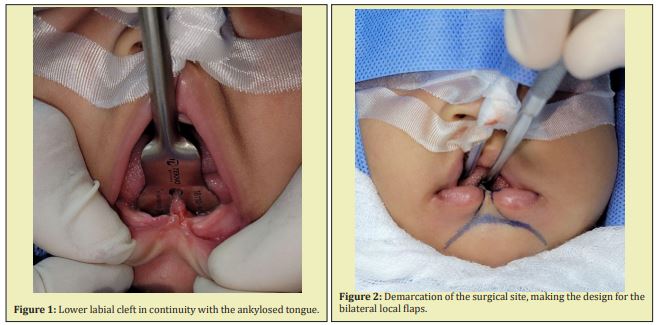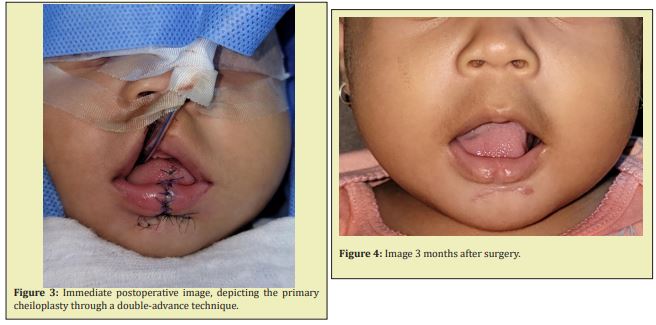The Objective is present a case of a medial cleft of the lower lip with associated ankyloglossia and a proposal for a double-advance local flap technique for its closure who attended the Oral and Maxillofacial Surgery Service of the Madre Rafols Hospital, Venezuela. A 4-month-old female patient, presenting a medial cleft of the lower lip with an associated aberrant frenulum of the tongue causing ankyloglossia (Tessier 30). Lingual frenectomy and primary cheiloplasty were performed with a double-advance local flap technique to close the lower labial cleft. A wedge-shaped incision along the labial cleft, with lateral extensions towards the mentolabial sulcus extending bilaterally were performed in order to advance both flaps and place the wound at the limit of the esthetic subunit, as well as a Z-plasty in the vermilion of the lower lip. Postoperative follow-ups did not reveal local complications or tissue dehiscence. Due to the rarity of this entity, relevant surgical techniques for this type of anomaly have not been established or evaluated. The technique presented here proved its usefulness, achieving harmonious and favorable functional and aesthetic results in our patient.
Keywords: Cleft, Ankyloglossia, Lower lip, Labial cleft
Clefts of the lower lip are a rare condition. Abnormal or incomplete development of structures derived from the lower half of the first branchial arch is extremely rare.1 Until now, only 75 to 80 documented cases have been reported in recent years.2 This condition varies in severity. On the mildest form, it can present as a notch in the submucosa of the lower lip and in the most severe form it can involve the lower lip as a whole, as well as ankyloglossia or bifid tongue, cleft of the alveolar process, mandible, floor of the mouth and even some structures of the neck.1,2 This alteration can be associated with syndromes or present isolated.3 At present, there are no specific surgical techniques described for this type of anomalies including primary closures for the harmony of the affected structures. The following case report aims to present a clinical case of a lower cleft lip with associated ankyloglossia and a proposed double advance local flap technique for closure of the lower labial cleft.
A 4-month-old female patient, brought by her parents to the Oral and Maxillofacial Surgery Service of the Madre Rafols Hospital in Maracaibo, Venezuela, who was referred by the pediatric dentist for presenting a lower medial labial cleft (Tessier 30) associated with type IV ankyloglossia according to Kotlow, since her birth Figure 1. Relevant pathologies and associated syndromes were ruled out from the medical history. Physical examination revealed a cleft at the level of the midline of the lower lip that included the vermilion up to the white line and the presence of an aberrant frenulum from the tip of the tongue, inserting into the lower lip and causing severe ankyloglossia. Due to these findings, under general anesthesia, a lingual frenectomy was performed with blunt technique, showing the release and mobility of the tongue in its entirety. Subsequently, a primary cheiloplasty was performed, using a double-advance local flap technique for closure of the lower labial cleft. Following demarcation of the fibrous tissue spanning along the extension of the labial cleft to the mentolabial sulcus and extending laterally to each side, a wedge-shaped incision was started along the median cleft with its lateral extensions from the mentolabial sulcus bilaterally Figure 2, in order to advance both flaps and place the wound at the limit of the aesthetic subunit, thus obtaining a tension-free surgical closure as well as hiding of the wound. Finally, a Z-plasty at the vermilion level of the lower lip was performed Figure 3. The closure was performed with 4-0 absorbable suture for mucosa and muscular planes, and 6-0 nylon for the cutaneous plane Figure 4. After 3 months of follow-ups, the patient has not presented any functional or aesthetic complications.


The inferior cleft lip is a rare anomaly, first described by Couronine in 1819 and since then very few cases have been described in the literature, with different severity and presentation.1 The failure of the mandibular prominences to join in the midline produces a central defect of the lower lip and chin, which is known as cleft number 30 by the Tessier classification.3 Early surgical intervention helps the child to feed and speak, thus avoiding alterations in function during growth. Sherman and Goulin reported the ideal time for soft tissue correction around 20 months of age to avoid such complications,1 in comparison with Singh Chauhana et al, where they determined an ideal age around 6 months of age,2 as did Millard et al, in which they affirmed early closure at approximately 6 months of life, with aesthetic and functional corrections at approximately 8 years of life if required, due to different causes such as scar contractures or for muscle restitution in order to improve its function.1
Various authors report that according to the presentation of the cleft and the affected anatomical structures, its surgical treatment will be defined. On the other hand, Jin Shi5 reported that in situations where bone tissue is affected by the cleft, an early primary intervention should be performed to correct soft tissue defects, and subsequent surgery to correct and increase stability of the jaw especially in cases where the aesthetics and projection of the chin are affected, preferably in puberty stages.2,4,5
Seyhan4 reported a simple V-shape excision, followed by a 3-layer closure for oral mucosa, muscle and skin, where no post-operative complications or wound dehiscences were determined in cases similar to the case hereby presented. However, our proposal for the management of the cleft with a local double-advance flap technique promotes the reduction of soft tissue collapse by decreasing the tension applied to the surgical wound after the removal of the fibers associated with the cleft, thus reducing said postoperative complications, maintaining the harmony and function of this important facial aesthetic unit.
None.
None.
Author declares that there is no conflict of interest.
- 1. Chidzonga MM, Lopez Perez VM, Mzezewa S. Treatment of median cleft of the lower lip, mandible, and bifidtongue with ankyloglossia. J Oral Maxillofac Surg. 1996;25:272–273.
- 2. Jaideep Singh Chauhan, Sharma S. Median cleft of lower lip with ankyloglossia: A case report. Oral and MaxillofacialSurgery Cases. 2019;5:100115.
- 3. Parit Ladani, Sailer HF, Sabnis R. Tessier 30 symphyseal mandibular cleft: Early simultaneous soft and hard tissue correction. A case report. Journal of Cranio-Maxillo-Facial Surgery. 2013;41(8):735–739.
- 4. Tamer Seyhan. Hydyr Kylyn. Median Cleft of The Lower Lip: Report of Two New Cases and Review of the Literature. Ann Otol Rhinal Laryngology. 2002;111(3).
- 5. Shia J, Zhanga J, Ding M, et al. Lower lip cleft, bifid tongue and fibrolipoma: a case report ofrare congenital anomaly. Br J of Oral and Maxillofac Surg. 2014;52(7):e36–e38.

